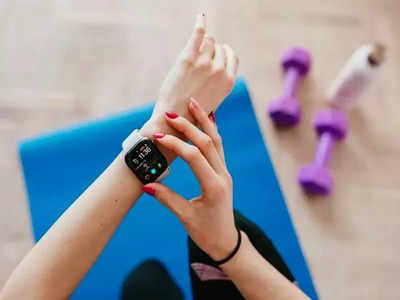Trending
This story is from May 25, 2023
Empowering personal health: The role of wearable devices in preventive medicine

In its most basic version, wearable health equipment is a spectacle. 300 years ago, the Chinese wore an abacus ring with seven rods and seven beads on each rod to help with calculations. In 1961, Edward Thorpe designed the Roulette Shoe, a gambling shoe device to get the better of roulette tables in casinos and the first example of a wearable computer.
In 1990, Back to the Future II struck a chord with many for its scientific aspect or due to the obvious look into daily life 30 years into the future in 2015, predicting possible interesting scientific advances.It got many things right, like video phones and 3D advertisements. One scene shows self-resizing shoes and clothes, auto-dampness detection, and then self-drying clothes. It at least got one thing right: wearable technology. Wearable technology in healthcare is any device worn or attached to one’s body and designed to help improve health and also collect needed data from the one wearing it on varied health-related issues. It may be possible to send health information to a healthcare professional in real-time. Pacemakers were an early example, but they differed in that they were implantable and not removable.
The watch became the obvious first choice of tech companies, soon followed by devices dedicated to health data, which incidentally also told the time. Smartwatches were more phone replacements - reading notifications, sending messages, making calls and offering exercise and health-tracking data. The technology would obviously take off in industrial-level health care, with profound impact in:
Preventive care is our focus. Monitoring the heart rate, blood pressure, calories burned, steps achieved, exercise time, and physical strain are basic data. These same exercises are useful for a patient with, say, heart failure who needs the exercise but also needs to limit it so as not to overexert themselves. Many suffer from heart rhythm disturbances, which can be life-threatening or just plain uncomfortable. Detecting these and performing more appropriate advanced tests helps plan an accurate treatment. Detection can be a challenge as they occur suddenly and may be self-limiting. Either the patient runs to the ER when it occurs, hoping it lasts long enough till the ECG gets done, or the patient uses a wearable that records ECG to detect the problem and prevent harm from a diagnostic delay.
In a recent European Urology Conference, Prof. Faysal Yafi presented a lecture on "Wearables for Erectile Quality: Catchy Gadget or Valuable Clinical Instrument?" devices or gadgets gaining popularity for sexual function tracking, erectile dysfunction (ED), and premature ejaculation (PE). The most common device, Rigiscan, has robust evidence but is outdated. FirmTech and Xialla need more evidence. For PE, the vPatch is the only device with efficacy and is soon to be available as a DTC (direct-to-consumer) option.
As we look ahead, the future of wearables holds tremendous promise. Smart hearables, smart patches, smart clothing, and smart implantables are among the most exciting segments to watch. With each advancement, wearables are propelling progress in healthcare and transforming the way we approach wellness. So, keep an eye on this space as wearables continue to shape the future of healthcare, enabling us to lead healthier lives and make informed decisions about our well-being.
- By Dr Rajesh Jaria, Consultant, Internal Medicine, P D Hinduja Hospital & Medical Research Centre, Khar
*The views/suggestions/opinions expressed in the article are the sole responsibility of the experts
In 1990, Back to the Future II struck a chord with many for its scientific aspect or due to the obvious look into daily life 30 years into the future in 2015, predicting possible interesting scientific advances.It got many things right, like video phones and 3D advertisements. One scene shows self-resizing shoes and clothes, auto-dampness detection, and then self-drying clothes. It at least got one thing right: wearable technology. Wearable technology in healthcare is any device worn or attached to one’s body and designed to help improve health and also collect needed data from the one wearing it on varied health-related issues. It may be possible to send health information to a healthcare professional in real-time. Pacemakers were an early example, but they differed in that they were implantable and not removable.
The watch became the obvious first choice of tech companies, soon followed by devices dedicated to health data, which incidentally also told the time. Smartwatches were more phone replacements - reading notifications, sending messages, making calls and offering exercise and health-tracking data. The technology would obviously take off in industrial-level health care, with profound impact in:
- Preventive Care
- Patient Engagement
- Patient Adherence
- Patient Self-management
- Diagnostics and newer therapies
Daycare heart surgery, for example, atrial fibrillation ablation surgery with same day discharge, is significantly safer if the patient can also be long-distance monitored at home, preventing many false-alarm re-admissions. Wearables find application in COVID-19 prediction, fertility tracking, heat-related illness, drug effects, and psychological interventions. A significant advantage of them is that they also include underrepresented populations, e.g., individuals with rare diseases, and are now entering into forecasting models as big data extracted from wearables potentially transforms understanding of population health dynamics and health trends. The best aspect of wearables is their non-invasive nature.
In a recent European Urology Conference, Prof. Faysal Yafi presented a lecture on "Wearables for Erectile Quality: Catchy Gadget or Valuable Clinical Instrument?" devices or gadgets gaining popularity for sexual function tracking, erectile dysfunction (ED), and premature ejaculation (PE). The most common device, Rigiscan, has robust evidence but is outdated. FirmTech and Xialla need more evidence. For PE, the vPatch is the only device with efficacy and is soon to be available as a DTC (direct-to-consumer) option.
As we look ahead, the future of wearables holds tremendous promise. Smart hearables, smart patches, smart clothing, and smart implantables are among the most exciting segments to watch. With each advancement, wearables are propelling progress in healthcare and transforming the way we approach wellness. So, keep an eye on this space as wearables continue to shape the future of healthcare, enabling us to lead healthier lives and make informed decisions about our well-being.
- By Dr Rajesh Jaria, Consultant, Internal Medicine, P D Hinduja Hospital & Medical Research Centre, Khar
*The views/suggestions/opinions expressed in the article are the sole responsibility of the experts
End of Article
FOLLOW US ON SOCIAL MEDIA









